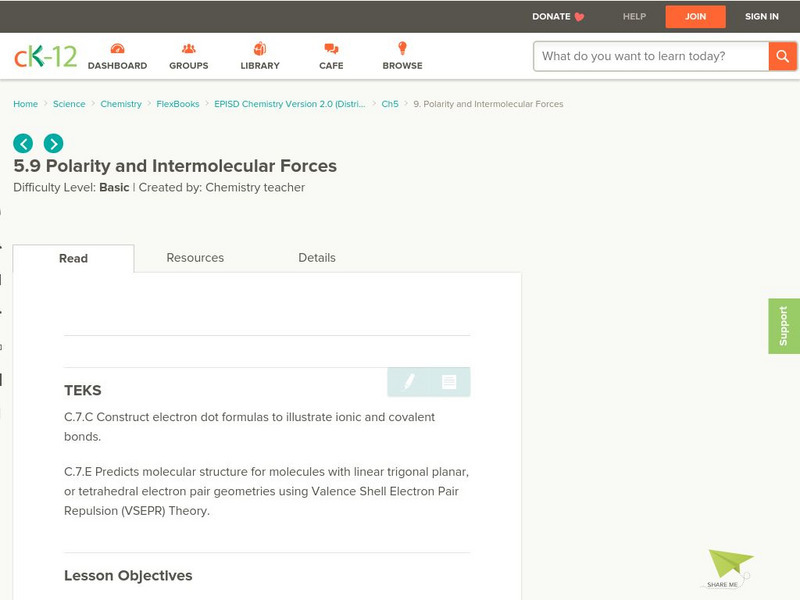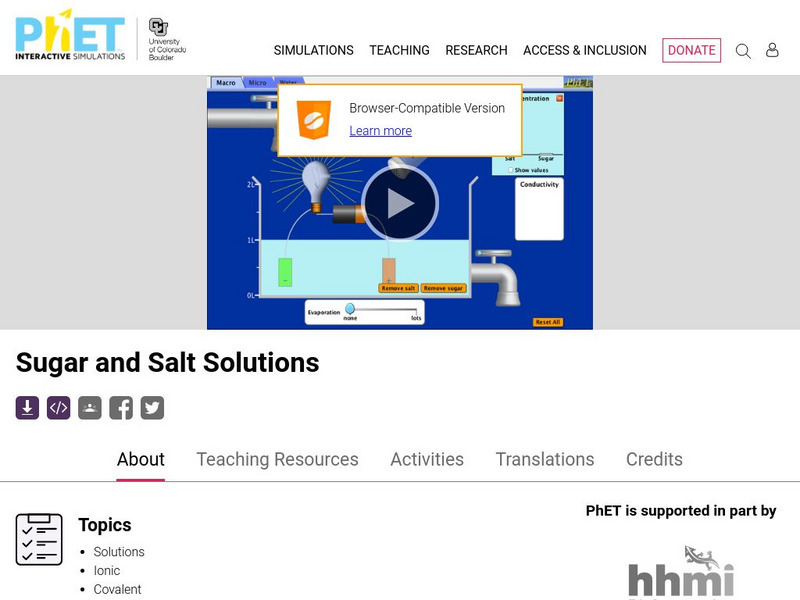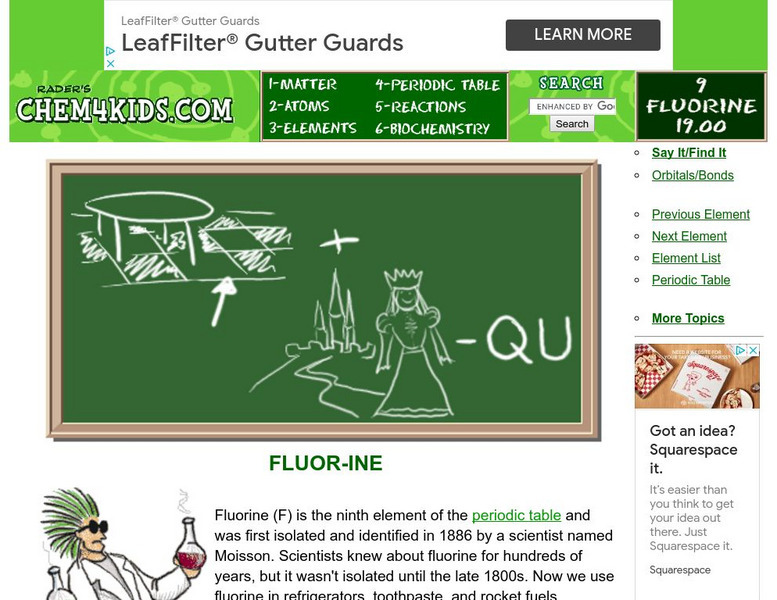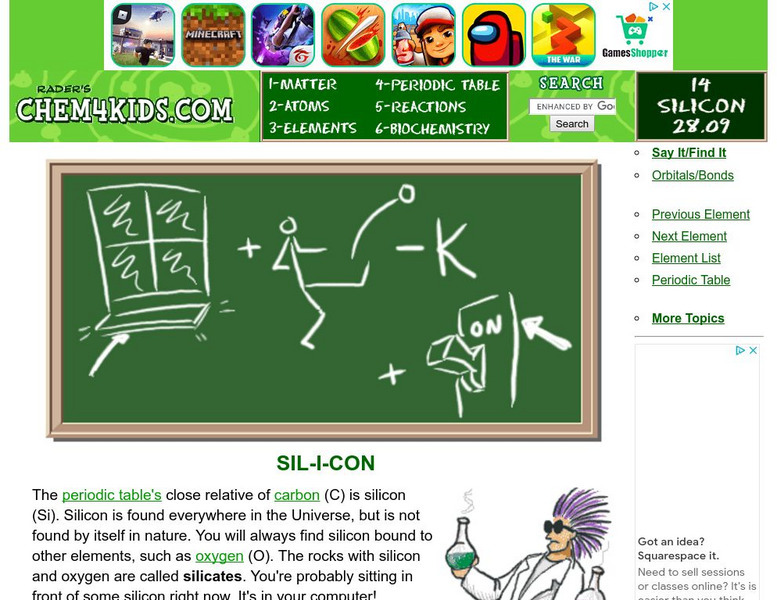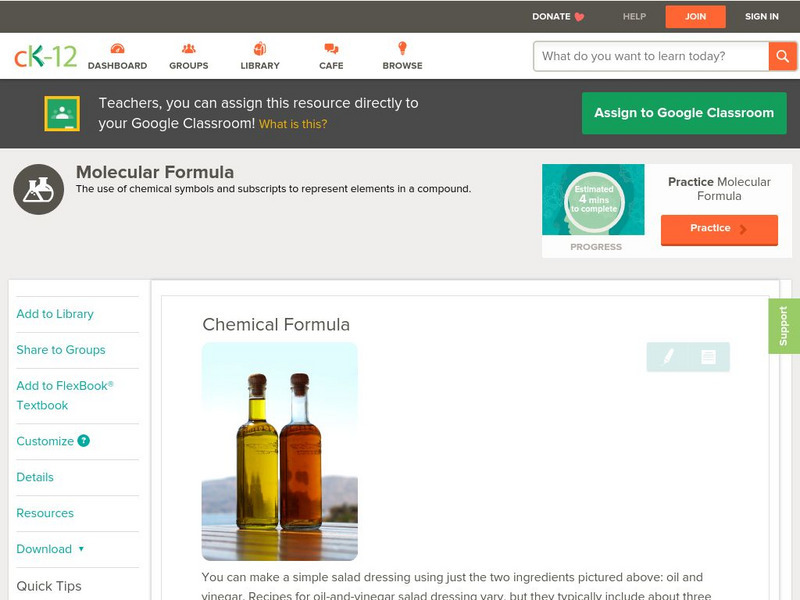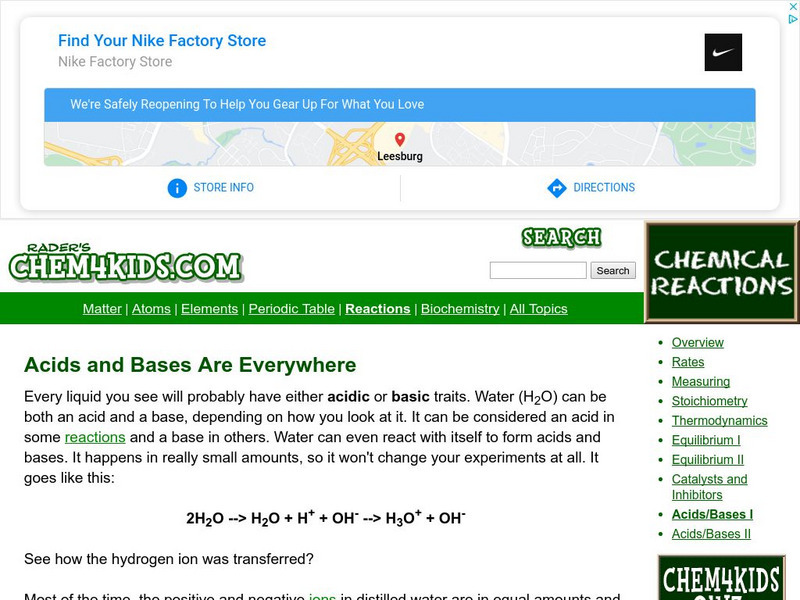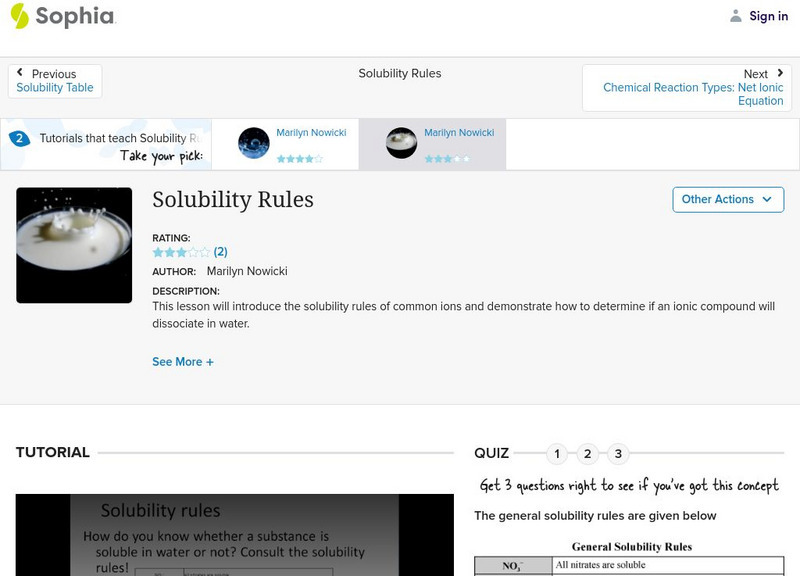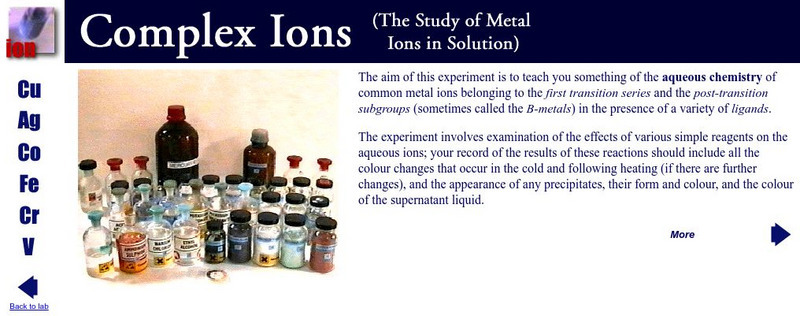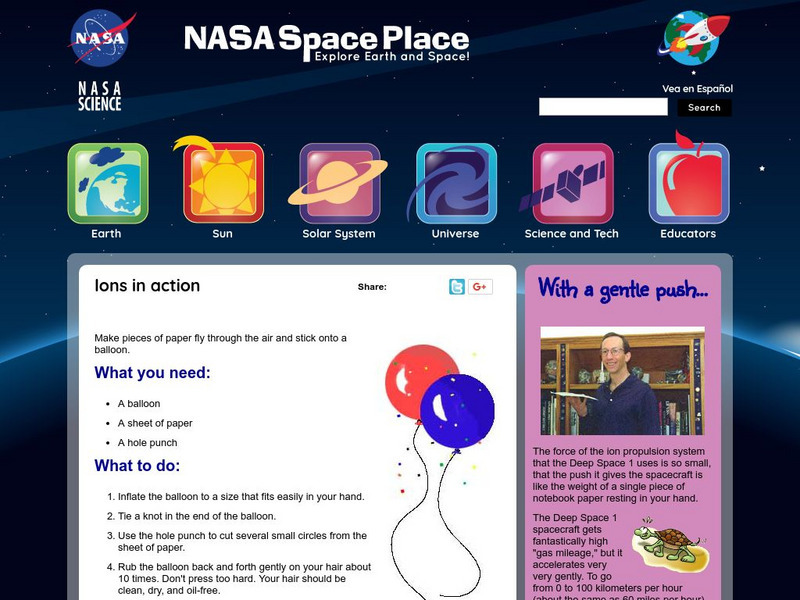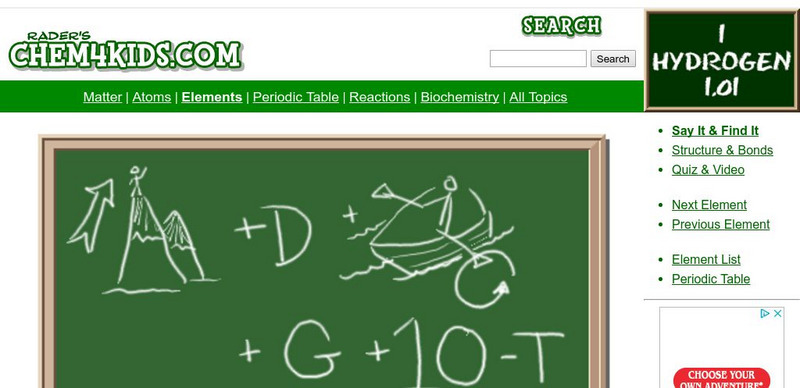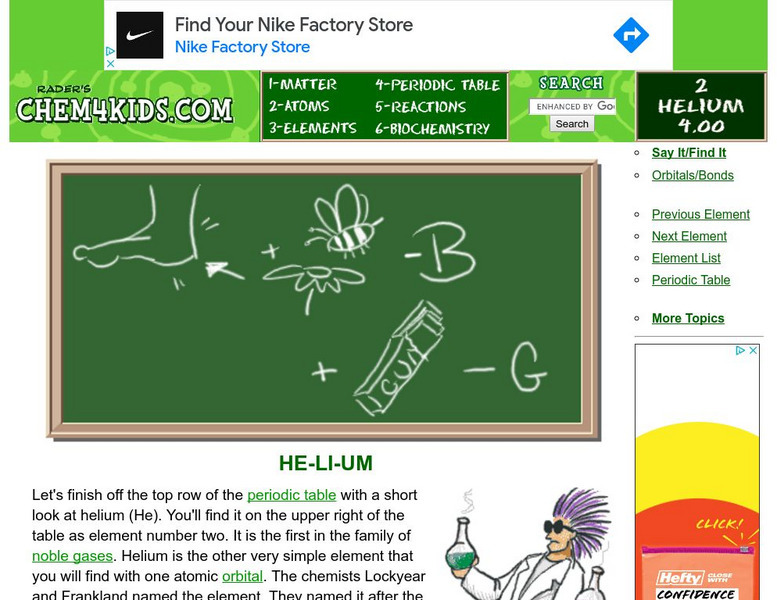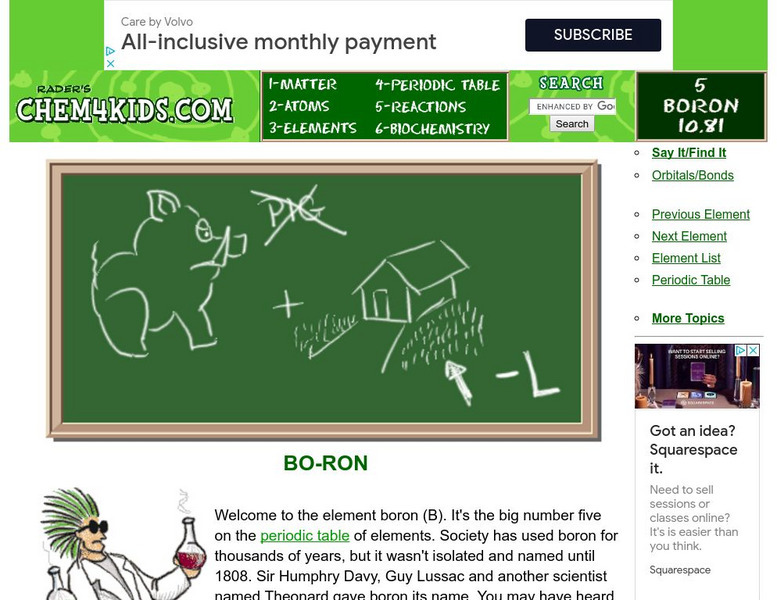Chiral Publishing
Chiral Publishing: An Introduction to Chemistry: Compounds and Chemical Bonds: Audio Book
Did you ever wonder how or why atoms bond together? This interactive tutorial sheds some light on why bonds form and the difference between ionic and covalent bonds.
CK-12 Foundation
Ck 12: Solubility Equilibrium
[Free Registration/Login may be required to access all resource tools.] Students write the solubility product constant expressions for nearly insoluble ionic compounds and perform calculations for compounds and solubility.
Chiral Publishing
Chiral Publishing: An Introduction to Chemistry: Oxidation Reduction Reactions: Audio Book
Listen to this audio book on Chapter 6, Oxidation-Reduction Reactions. View chapter maps, binary ionic compounds, memory aids, and examples of different chemical reactions.
CK-12 Foundation
Ck 12: Polarity and Intermolecular Forces
[Free Registration/Login may be required to access all resource tools.] The following online tutorial describes how the electronegativity difference between two atoms in a covalent bond results in the formation of a nonpolar covalent,...
University of Colorado
University of Colorado: Ph Et Interactive Simulations: Sugar and Salt Solutions
What happens when sugar and salt are added to water? Pour in sugar, shake in salt, and evaporate water to see the effects on concentration and conductivity. Zoom in to see how different sugar and salt compounds dissolve. Zoom in again to...
PBS
Pbs Learning Media: Chemical Bonds
This interactive activity developed for Teachers' Domain demonstrates how attractive forces between atoms create chemical bonds, resulting in the formation of molecules and compounds.
Utah Education Network
Uen: Conductivity and Bonding
Students will measure the conductivity of several compounds and solutions in order to predict the bond types (ionic or covalent) in the substances tested.
Chiral Publishing
Chiral Publishing: An Introduction to Chemistry: An Introduction to Chemical Reactions [Pdf] [Pdf]
A detailed introduction to chemical reactions, organized into two sections: "Chemical Reactions and Chemical Equations" and "Solubility of Ionic Compounds and Precipitation Reactions." Complete with examples, charts, and equations, this...
Chem4kids
Chem4 Kids: Fluorine
Here you can find some great information about the 9th element in the periodic table, "fluorine." Content focuses on fluorine's electrons, where you can find fluorine in nature and in the home, and how fluorine combines with other elements.
Chem4kids
Chem4 Kids: Silicon (Si)
Here you can find some great information about the 14th element in the periodic table, "silicon." Content focuses on silicon's electrons, where you can find silicon in nature and in the home, and how silicon combines with other elements.
CK-12 Foundation
Ck 12: Physical Science: Chemical Formula
[Free Registration/Login may be required to access all resource tools.] How to write chemical formulae and what they represent about the substance.
Chem4kids
Chem4 Kids: Acids & Bases
This Chem4Kids site provides a general overview of acids and bases, and their use in chemistry. Content focuses on "names to know" and how acids and bases work.
Sophia Learning
Sophia: Solubility Rules
A narrated screencast which describes the solubility rules of common ions. [4:23]
Georgia State University
Georgia State University: Hyper Physics: Precipitation Reactions
This site from Georgia State University discusses the precipitation reactions and deals with the lead iodide product. Links are provided to information on double replacement reactions as well as ionic compounds. Not too in-depth, this is...
Geography 4 kids
Geography4 kids.com: Cycling Phosphorus
An essential element in the ecosystem is phosphorus. Discover the phosphorus cycle, what depends upon it, and how it works.
CK-12 Foundation
Ck 12: Physical Science: Transition Metals
[Free Registration/Login may be required to access all resource tools.] Group 3-12 elements and their properties.
CK-12 Foundation
Ck 12: Chemistry: Names and Formulas of Bases
[Free Registration/Login may be required to access all resource tools.] Covers names and formulas of bases.
University of Oxford (UK)
Complex Ions: The Study of Metal Ions in Solution
This site provides examples of ionization with the use of Quicktime video clips.
University of Waterloo (Canada)
University of Waterloo: Lattice Energy
This site from the University of Waterloo provides in-depth and advanced information on lattice energy. the site is designed to answer the two major questions, how is lattice energy estimated using Born Haber cycle, and how is lattice...
NASA
Nasa: The Space Place: Ions in Action
The page from NASA's The Space Place describes a simple activity, charging a balloon and making it move small pieces of paper. It then goes on to give an excellent explanation of how the activity works, and how it involves ions. This...
Chem4kids
Chem4 Kids: Hydrogen
Here you can find out about hydrogen, the first element in the periodic table. Content includes shell information, where to find it in nature, and why it is helpful to us.
Chem4kids
Chem4 Kids: Helium
Here you can find lots of great information about helium. Learn about its electrons, where it exists in nature, and about the element itself!
Chem4kids
Chem4 Kids: Boron
Here at Chem4Kids.com you can find some great information about the 5th element in the periodic table, "boron." Content focuses on boron's electrons, where you can find boron in nature and in the home, and how boron combines with other...
Chem4kids
Chem4 Kids: Carbon
Click on the left navigation terms for some great information about the 6th element in the periodic table, "carbon." Content focuses on carbon's electrons, where you can find carbon in nature and in the home, and how carbon combines with...
Other popular searches
- Naming Ionic Compounds
- Binary Ionic Compounds
- Ionic Compounds Lab
- Covalent and Ionic Compounds
- Ionic Compounds Nomenclature
- Drawing Ionic Compounds
- Chemistry Ionic Compounds
- Building Ionic Compounds
- Chapter 5 Ionic Compounds
- Ionic Compounds Activity
- Writing Ionic Compounds
- Properties of Ionic Compounds


